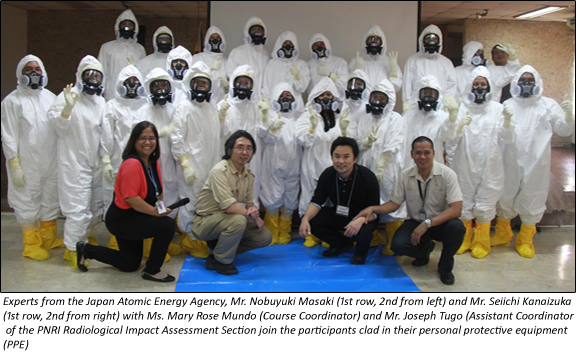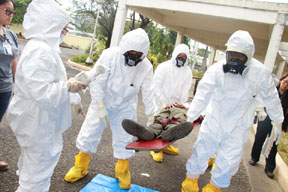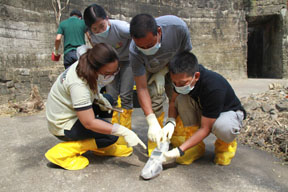


Left Photo: Participants, wearing their PPE, rescue a victim in an integrated radiological emergency field exercise involving radiological dispersal devices (RDDs)
Right Photo: The participants scan the area for radioactive contamination using a survey meter
The Department of Science and Technology – Philippine Nuclear Research Institute (DOST-PNRI) in cooperation with the Japan Atomic Energy Agency (JAEA) conducted the Follow-up Training Course on Nuclear/Radiological Emergency Preparedness and Response from February 9-13 at the PNRI Compound.
The five-day national workshop provided participants with the basic understanding of the principles of radiation protection, enhanced the emergency response capabilities of the various member agencies of the National Radiological Emergency Preparedness and Response Plan (RADPLAN) and provided practical guidance on communication principles during nuclear and radiological emergencies.
The workshop was attended by twenty-five (25) representatives of RADPLAN agencies and PNRI staff, including the, National Disaster Risk Reduction and Management Council (NDRRMC), Quezon City Disaster Risk Reduction and Management Office (QCDRRMO), Philippine National Police – Quezon City Police District (PNP-QCPD), Health Emergency Management Bureau (HEMB-DOH), Bureau of Fire Protection – Quezon City (BFP-QC-DILG), Philippine Army Explosives and Ordnance Disposal Battalion (AFP-EOD) and the Metropolitan Manila Development Authority (MMDA).
The workshop was supervised by two (2) JAEA experts, Mr. Nobuyuki Masaki and Mr. Seiichi Kanaizuka, who also served as consultants and eight (8) PNRI staff, Ms. Mary Rose Mundo (Workshop Coordinator), Ms. Haydee Solomon, Mr. Joseph Tugo, Mr. Frank Pares, Mr. Teofilo Leonin, Ms. Cecile De Vera, Mr. Carl Nohay, Ms. Teresa Salabit and Dr. Emma Cansino, who served as lecturers and evaluators.
The workshop consisted of lectures and practical exercises/drills on radiation safety, protection and survey, decontamination techniques, and environmental monitoring during nuclear and radiological emergencies.
The highlight of the workshop was the integrated radiological field exercise which provided the participants with practical learning on the concept of operations during response to a radiological emergency and the roles & responsibilities of RADPLAN agenciesin a simulated field exercise involving a radiological dispersal device (RDD).












































